#ankylosaurians
Explore tagged Tumblr posts
Text
Archovember 2024 Day 5 - Gargoyleosaurus parkpinorum

Living in Late Jurassic Wyoming, USA, Gargoyleosaurus parkpinorum is one of the earliest ankylosaurs known from mostly complete fossil remains. It was a nodosaur, part of a family of ankylosaurs that lacked club-tails. Gargoyleosaurus would have instead relied on its body armour and sharp shoulder spikes for defense. It was relatively small, reaching 3–3.5 m (9.8–11.5 ft) long and weighing an estimated 300–754 kg (661–1,662 lb). Like other nodosaurs, it was likely a herbivore, swallowing ferns, cycads, and angiosperms, and relying on symbiotic bacteria and gut flora to digest its food.

Gargoyleosaurus lived in the diverse Morrison Formation. In Wyoming, it would have lived alongside stegosaurs Alcovasaurus and, of course, Stegosaurus. Ornithopods like Camptosaurus and Dryosaurus would have also shared this space. But the Morrison is most famous for its vast array of sauropods, and Gargoyleosaurus would have lived alongside Dyslocosaurus, Apatosaurus, Ardetosaurus, Brontosaurus, Barosaurus, Diplodocus, Galeamopus, Supersaurus, and Camarasaurus. Gargoyleosaurus could have been hunted by the many predators that made Late Jurassic Wyoming home, including Allosaurus, Ceratosaurus, Fosterovenator, and Torvosaurus. It would have also lived alongside smaller theropods like Coelurus, Hesperornithoides, Ornitholestes, and Tanycolagreus.

This art may be used for educational purposes, with credit, but please contact me first for permission before using my art. I would like to know where and how it is being used. If you don’t have something to add that was not already addressed in this caption, please do not repost this art. Thank you!
#Gargoyleosaurus parkpinorum#Gargoyleosaurus#nodosaur#ankylosaurians#thyreophorans#ornithischians#dinosaurs#archosaurs#archosauromorphs#reptiles#Archovember#Archovember2024#dinovember#Dinovember2024#DrawDinovember#DrawDinovember2024#SaritaDrawsPalaeo#Late Jurassic#USA#Morrison Formation
79 notes
·
View notes
Text
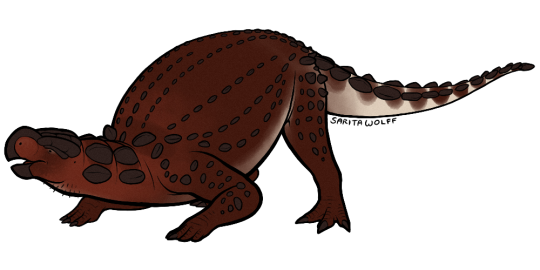
#Archovember Day 23 - Kunbarrasaurus ieversi
In the Early Cretaceous of Australia lived the small, basal ankylosaurian Kunbarrasaurus ieversi. Originally thought to be a species of Minmi, Kunbarrasaurus was eventually discovered to be a new genus of ankylosaur and renamed in 2015. One specimen is the most complete dinosaur fossil ever found in Australia, even containing gut contents! This Kunbarrasaurus’ last meal consisted of plant tissue fragments, whole fruits, and whole seeds. The tissue fragments are small and seem to have been nibbled or chopped by the ankylosaur. Unlike some other dinosaurs, it lacked any gastroliths, leading paleontologists to believe it had a more sophisticated method of grinding up its food.
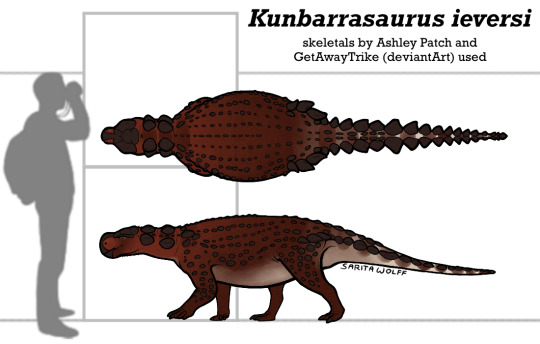
Kunbarrasaurus fossils have been found in marine sediment, so they were likely swept out to the shallow inland sea that covered Queensland during the Early Cretaceous. However, some other unfortunate dinosaurs have also been found in the same Allaru Formation. These include the titanosaur Austrosaurus and the iguanodontian Muttaburrasaurus.
#my art#SaritaDrawsPalaeo#Kunbarrasaurus ieversi#Kunbarrasaurus#Parankylosaurian#Parankylosaur#ankylosaurs#ankylosaurians#thyreophorans#ornithischians#dinosaurs#archosaurs#archosauromorphs#reptiles#Archovember#Archovember2023
28 notes
·
View notes
Text

hawkeye no!!!
you're a surgeon not a paleoveterinarian! what are you doing in the Early Cretaceous?!

#bc im a pedant this is an accurate meme#the ankylosaurian polycanthus: “Taohelong jinchengensis” lived in northern china up till 100 mya#mash 4077#mash memes#the timeloop is getting complicated guys#ogmachinations
85 notes
·
View notes
Text
Tianzhenosaurus chengi Pang et al., 2024 (new species)

(Skeleton of Tianzhenosaurus chengi including the type skull, from Pang et al., 2024)
Meaning of name: chengi = for Cheng Zheng-Wu [Chinese paleontologist]
Age: Late Cretaceous (Campanian)
Where found: Huiquanpu Formation, Shanxi, China
How much is known: A nearly complete skull and a nearly complete rest of the skeleton, presumably from the same individual.
Notes: T. chengi was an ankylosaurine ankylosaur, a group of armored dinosaurs known for their distinctive tail club. It was found at the same locality as the only other named species of Tianzhenosaurus, T. youngi, but differs from it in details of its armor plating, skull, and vertebrae. Some researchers have suggested that Tianzhenosaurus represents the same genus as Saichania, an ankylosaur otherwise known from the Late Cretaceous of Mongolia, though the describers of T. chengi maintain that the two are distinct enough to be considered separate.
Reference: Pang, Q., Z. Li, and Z. Guo. 2024. A new species of ankylosaurian dinosaur—Tianzhenosaurus chengi sp. nov., from the Late Cretaceous of Tianzhen County, Shanxi Province, China. Journal of Hebei GEO University 47: 41–73. doi: 10.13937/j.cnki.hbdzdxxb.2024.06.006
90 notes
·
View notes
Text


Ankylosaurian sacrum from our anky site. Campanian, Judith River fm near Havre, MT.
#badlands dinosaur museum#fossil#fossils#palaeoblr#paleoblr#paleontology#palaeontology#dinosaurs#fieldwork#judith river formation#fieldwork 2024
234 notes
·
View notes
Text
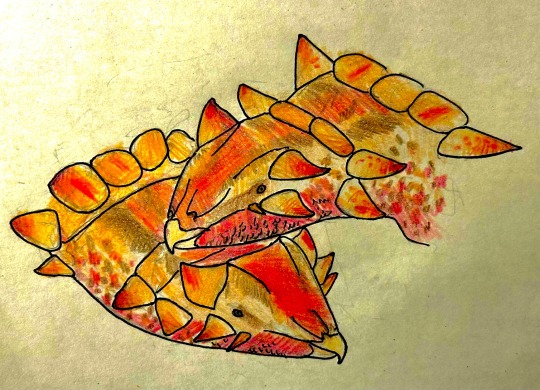
Impresssion of the newly-discovered ankylosaurian dinosaur Datai yingliangis, which lived about 96-90 million years ago in the Late Cretaceous of what is now the Zhoutian Formation of China’s Jiangxi Priovince.
#paleoart#dinosaur#dinosaurs#paleontology#datai#ankylosauria#ornithischians#ornithischian#ornithischia#datai yingliangis
70 notes
·
View notes
Text
while researching maryland dinosaurs for work i found out that there are a weird amount of nodosaur fossils here and i am beside myself with emotions for two notable fossils of very young nodosaurs

this tiny hatchling was found in college park and the whole fossil is only 13 centimeters long. even with the other half of its body it would've have fit in my hands, at only just a foot long. this is the youngest nodosaur ever found, and was so young it was likely still confined to its nest and the immediate area around it. this poor hatchling was under a year of age when it was likely swept from in or around its nest by a flood and immediately buried by silt, belly up, leaving the impressions of its armored forehead that had yet to grow many of the characteristic osteoderms of adult nodosaurs. there are preserved footprints of hatchlings the exact same size found very close to the body, possibly the footprints of siblings or even the same individual. the size of it has me continually imagining holding it, this guy was so small and so young. i want to hold that little splayed out hand.

there's also a fantastic cretaceous trackway that was found outside the goddard space center, and though the highlight is how many mammals are present and almost my entire thing is early mammals and trace fossils i am most enamored with the nodosaur tracks. some of the tracks may be the smallest ankylosaurian tracks ever found. they're present with a much larger adult, perhaps of the same taxa, perhaps even a parent. the one print that really gets me is the singular adult nodosaur print in the whole trackway, which has a baby's footprint inside of it, just slightly deformed to suggest that it slipped in its parent's footprint. 110 million years ago a kid slipped in the mud trying to keep up with it parent.
references and more pics for those interested (i highly recommend looking at the full trackway, there's some really cool mammal and even pterosaur prints!!!):
The First Hatchling Dinosaur Reported from the Eastern United States: Propanoplosaurus marylandicus (Dinosauria: Ankylosauria) from the Early Cretaceous of Maryland, U.S.A.
Little nodosaur fossil found in College Park
New dinosaur species named from hatchling fossil donated to National Museum of Natural History
A diverse mammal-dominated, footprint assemblage from wetland deposits in the Lower Cretaceous of Maryland
Spectacular dinosaur stomping grounds discovered just outside D.C.
#every fossil i ever see or hold i always wonder what their life was like as an individual and these ones just really got to me#how was your life little one. for however long or short you lived. we know so much but also so little about you#dinosaurs
15 notes
·
View notes
Text
Sauricthys, a triassic fish Savannasaurus, a cretaceous sauropod dinosaur Serendipaceratops, an ankylosaurian dinosaur that one guy thinks is a ceratopsian dinosaur Silvabestius, a cenozoic arboreal? diprotodontid marsupial Simosthenurus, a cenozoic short-faced kangaroo Steropodon, a cretaceous platypus






#palaeoblr#australian fossil alphabet thing#megafauna#dinosaur#Sauricthys#Savannasaurus#Serendipaceratops#Silvabestius#Simosthenurus#Steropodon
22 notes
·
View notes
Text
Vectipelta

Vectipelta is a genus of ankylosaurian dinosaur from the Early Cretaceous Wessex Formation of England. The name is derived from "Vectis", the Roman name for the Isle of Wight. Like other ankylosaurs, it was a large herbivore with short legs and a wide, flat body, covered in osteoderms and spikes. Although it was discovered in England, Vectipelta was not very closely related to other ankylosaurs in the same area. It was actually most closely related to Chinese ankylosaurs, suggesting dinosaurs moved freely from Asia to Europe in the Early Cretaceous.
66 notes
·
View notes
Text
Stegosaurus ("Roof Lizard") was a large herbivorous dinosaur from the late Jurassic period (155-145 Mya) and has been found in the western United States and Portugal.
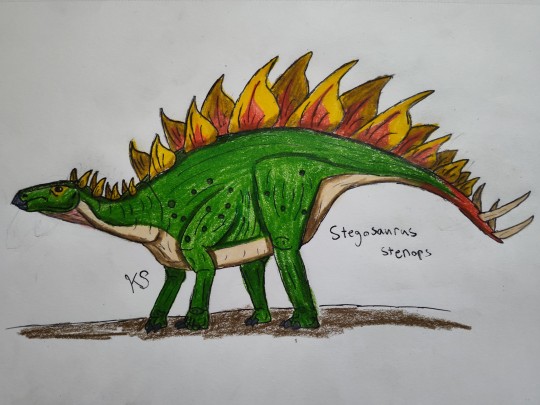
This iconic thyreophoran dinosaur is known for the intimidating plates along its back which it probably used for protection or display, and for the weaponized spiked tail it likely used to fend off predators.
Thyreophora is a diverse group of armored Ornithischian dinosaurs including Stegosauria, Ankylosauria, and their common ancestors. Evolution has experimented with armor several times throughout history but thyreophorans may be some of the most heavily armored animals we know of. With plates and spikes in all sorts of arrangements and sizes, and the later tank-like Ankylosaurs with hundreds of osteoderms and a heavy club-like tail.
Stegosaurians ranged from the middle Jurassic and into the early Cretaceous, while the Ankylosaurians lasted all the way to the end of the Cretaceous. Unfortunately their heavy armor wasn't enough to save them from the asteroid impact.
14 notes
·
View notes
Text
This year has gone by fast! There are only 44 more days left of 2023 so to celebrate I’m gonna make a post about five extinct animals that were described this year!
1. Bos primigenius thrinacius n. ssp.
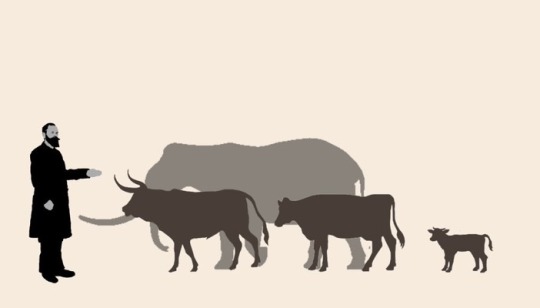
(Bos primigenius thrinacius n. ssp. Size estimate of a bull, cow, and calf compared to a human and an adult Palaeoloxodon falconeri. Art by Joschua Knüppe)
This new sub species of Aurochs lived on the Greek island of Kythera during the Late Pleistocene. The sub species was probably present on Kythera while it was still part of the mainland, but became trapped when it was separated sometime during the Middle to Late Pleistocene and their small size was a result of insular dwarfism. Insular dwarfism is a common phenomenon in evolution where a population of large animals becomes trapped on an island and slowly evolve to become smaller over time to better adapt to the reduced space and resources. The opposite, insular gigantism, where an island-bound population of small animals grows larger than their mainland counterparts also occurs regularly. During the Pleistocene, the various islands of Greece were full of giant swans and miniature elephants but now we know they had tiny cattle roaming about as well.
2. Garumbatitan morellensis
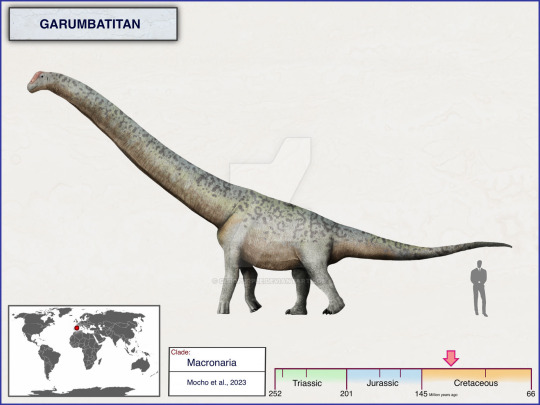
(Size comparison between Garumbatitan morellensis and a human. Art by cisiopurple on Deviantart)
Meaning “Garumba Giant”, Garumbatitan morellensis was a species of sauropod dinosaur that lived during the Cretaceous period in what is now Spain. Its remains were first discovered in 1998 at the Arcillas de Morella Formation near the city of Morella, however, they would not be excavated until an expedition in 2005. More material would later be discovered in a 2008 expedition and a paper would be published on the findings in 2016, but it wasn’t until this year that the species was officially named and described. Its genus named is a mix of the name for the tallest mountain in the region it was discovered in, Mola de la Garumba, and the Greek word “Titan”.
3. Nihohae matakoi
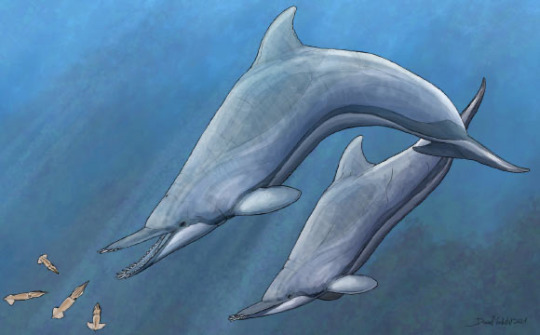
(A pair of Nihohae matakoi hunting some squid. Art by Daniel Verhelst)
Nihohae matakoi was a species of dolphin that belonged to the now extinct Waipatiid family and lived during the Oligocene in the waters surrounding what is now New Zealand. It possessed a bizarre set of tusk-like teeth that protruded from its beak. It is thought that this dolphin used it’s strange teeth much like a sawfish to stun their prey before consuming them. The holotype specimen was discovered all the way back in 1998 in Awamoko Valley on New Zealand’s South Island. The specimen consisted of a nearly complete skull, a single atlas and axis, eight vertebrae, and seven ribs. However, Nihohae matakoi would not be officially described until 2023. Its genus name combines the Māori words “Niho”, meaning “teeth”, and “Hae”, meaning “slashing”. The species name is also derived from Māori and comes from the words “Mata”, meaning “face” or “point”, and “Koi”, meaning “sharp”.
4. Perucetus colossus
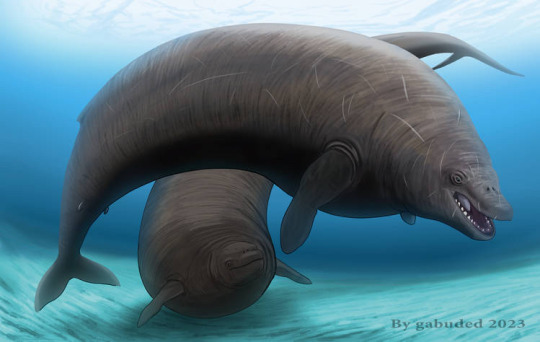
(A pair of Perucetus swim together in the shallows. Art by Gabuded on Deviantart)
Another cetacean, Perucetus colossus was a species of early whale that lived during the Bartonian age of the Middle Eocene and was found in Peru (obviously). The remains we have or Perucetus are pretty fragmentary, but it has an estimated length of around 55.8-65.9 ft and was probably just as, if not heavier, than the modern Blue Whale. Due to the density of its bones and its absolute chonkiness, Perucetus likely was not a fast swimmer and likely lived in shallow waters and fed on crustaceans and mollusks. However, this is just speculation as very little about its ecology is known.
5. Vectipelta barretti

(A pair of Vectipelta barretti graze near a stream. Art by Stuart Pond)
Vectipelta barretti was an ankylosaurian dinosaur that lived during the Early Cretaceous in what is now England. It was discovered in the Wessex Formation and it’s genus name means “Isle of Wight shield”. The holotype specimen of Vectipelta was originally discovered in November of 1993, however, at the time it was believed that the specimen belonged to the genus Polacanthus. In May of 2021 it was discovered that the specimen was in fact a new genus and in June of 2023 it was officially named and described. Funnily enough, fossil evidence suggests that Vectipelta might be millions of years older than Polacanthus, the genus it was originally thought to be a member of.
I hope you all enjoyed reading about these recently described prehistoric species! I LOVE dinosaurs and other extinct animals and can’t wait to see what new discoveries 2024 has to offer!
#dinosaur love#animals#new discoveries#infodump#science#dinosaur#peru#new zealand#isle of wight#Kythera#new species#animal news#animal facts#dinosaur facts#paleontology#spain#2023#ankylosauria#sauropod#aurochs#cetacean#perucetus
25 notes
·
View notes
Photo

Stegouros elengassen
In this artwork, two ankylosaurian dinosaurs called Stegouros from the Late Cretaceous engage in rivalry.
License this stock resource at: https://paleostock.com/resource/Stegouros-elengassen-stock-photo
Illustration by Mohamad Haghani
#paleoart#sciart#science#nature#paleontology#geology#fossil#fossils#evolution#art#illustration#paleostock
80 notes
·
View notes
Text
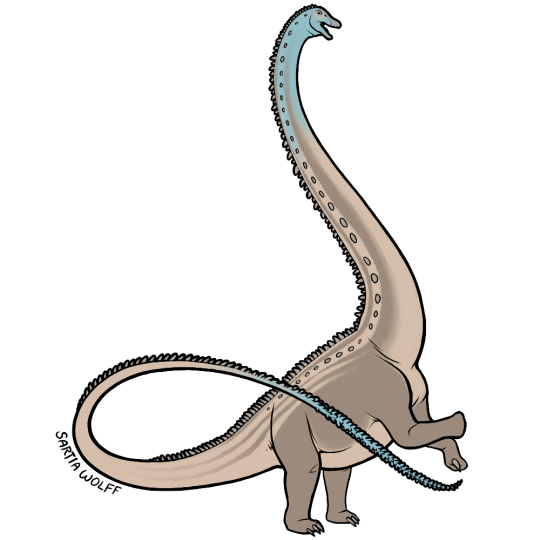
#Archovember Day 7 - Supersaurus vivianae
Living in Late Jurassic North America, the diplodocid Supersaurus vivianae was one of the largest and longest sauropods to ever exist. With larger specimens reaching 33–35 metres (108–115 ft) long and weighing an estimated 35–40 metric tons (39–44 short tons), it was matched only by the Late Cretaceous titanosaur Argentinosaurus.
As a diplodocid, Supersaurus would have used it’s long, peg-like teeth to strip food from branches and swallow it without chewing, instead relying on gastroliths (small stones) to break down plant material in its gizzard. Due to the high stress stripping branches would place on its teeth, diplodocids continuously replaced their teeth throughout their lives, usually in less than 35 days! Supersaurus could have had as many as 5 teeth developing per tooth socket.
Supersaurus, like other diplodocids, had a long, whiplike tail which tapered at the end. They could have snapped this tail like a bullwhip, generating a sonic boom. This could have been used in mating displays or to ward off predators.
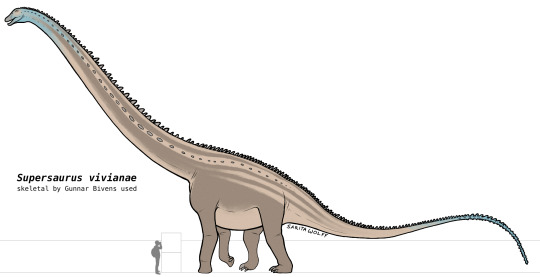
Being the largest animals living at the time, there weren’t many, if any, predators in the Morrison Formation that could have preyed on adult Supersauruses. However, young Supersauruses would have had a multitude of large theropods to look out for, including Allosaurus, Saurophaganax, Ceratosaurus, Torvosaurus, and Marshosaurus. Supersaurus would have lived alongside a variety of other sauropods such as Haplocanthosaurus, Smitanosaurus, Amphicoelias, Apatosaurus, Brontosaurus, Diplodocus, Brachiosaurus, Camarasaurus, Dystrophaeus, and the rare Barosaurus. There were a lot of Ornithischians in this formation as well, though not as numerous and diverse as the sauropods. They included the early ornithopods Camptosaurus, Dryosaurus, Nanosaurus, and Uteodon, the stegosaurians Alcovasaurus, Hesperosaurus, and Stegosaurus, the ankylosaurians Gargoyleosaurus and Mymoorapelta, and the heterodontosaur Fruitadens.
#my art#SaritaDrawsPalaeo#Supersaurus#Supersaurus vivianae#diplodocid#sauropods#saurischians#dinosaurs#archosaurs#archosauromorphs#reptiles#Archovember#Archovember2023
103 notes
·
View notes
Text
Tenukh

"DINOSAPIEN: THE DIGGERS" © deviantArt user Taliesaurus, accessed at his gallery here
[Sponsored by @glarnboudin. These are the antagonists from Dinosapien, a Discovery channel TV show after my time. They have three canon names, and I hate all of them. I've spoken before about my irritation with monsters that swipe names from mythology thoughtlessly. The unktehi is a horned aquatic serpent in Lakota lore, and this is 0 for 3. And since the term "digger" was used as an ethnic slur for a different group of native Americans, the name seems especially tone-deaf. If you're going to be making a TV show with Native terminology (misued), you should at least double check to make sure you're not using any slurs! A scientist character refers to them as "ornithosapiens", I guess because they're ornithischians, but that name should probably go to, you know, birds. I ended up creating my own name rearranging the letters of unktehi.]
Tenukh CR 4 CN Monstrous Humanoid This creature is a bipedal reptile the size of a bison. It is as broad as it is tall, with an armored carapace and a domed head. Its forelimbs end in clawed hands, and it carries a spear.
Tenukhs are cave-dwelling sapient dinosaurs, descended from ankylosaurians. They are insectivorous, and much of their lives revolve around tending to and harvesting colonial insects such as termites, ants, bees and wasps. They supplement these foods with other insects, roots and herbs, especially during the winter in regions where hives go dormant in cold weather. Tenukhs are clannish, xenophobic and territorial, and a creature that disturbs their hives (or worse, steals honey or larvae from them) may be chased to the ends of the earth.
Tenukhs are straight forward combatants. They typically fight in pairs, with one charging headfirst into melee with the other providing backup with a spear. They have short arms, and so have limited reach despite their size, so favor polearms when wielding melee weapons. Tenukhs are fascinated by explosives, and may beg borrow or steal to get them, even if they do not fully understand their use.
The tenukh language is spoken through the nose, as the creatures have complicated, muscular sinuses. They can learn to speak other languages with some effort, and especially intelligent or practiced tenukh may speak Aklo, Common, Dwarven, Goblin, or Undercommon.
Tenukh CR 4 XP 1,200 CN Large monstrous humanoid Init +4; Senses darkvision 60 ft., Perception +8, scent Defense AC 17, touch 9, flat-footed 17 (-1 size, +8 natural) hp 37 (5d10+10) Fort +5, Ref +4, Will +6 Resist acid 10 Defensive Abilities fortification (50%); Weakness light blindness Offense Speed 30 ft., burrow 10 ft. Melee masterwork longspear +8 (2d6+4/x3), slam +2 (1d8+1) or 2 claws +7 (1d6+3), slam +7 (1d8+3) Ranged chakram +4 (2d6+4) Space 10 ft.; Reach 5 ft. (10 ft. with longspear) Special Attacks powerful charge (slam, 2d8+4 plus stun), stun Statistics Str 16, Dex 10, Con 15, Int 8, Wis 15, Cha 9 Base Atk +5; CMB +9; CMD 29 (33 vs. bull rush, overrun, trip) Feats Great Fortitude, Improved Initiative, Intimidating Prowess, Martial Weapon Proficiency (chakram) (B) Skills Climb +9, Knowledge (dungeoneering) +2, Intimidate +8, Perception +8, Survival +8 Languages Tenukh Ecology Environment underground Organization solitary, pair or clan (3-12) Treasure standard (masterwork longspear, 3 chakram, other treasure) Special Attacks Stun (Ex) A creature struck by a tenukh’s slam attack on a powerful charge or a critical hit must succeed a DC 15 Fortitude save or be stunned for 1 round. The save DC is Strength based.
47 notes
·
View notes
Text
Vectipelta barretti Pond et al., 2023 (new genus and species)
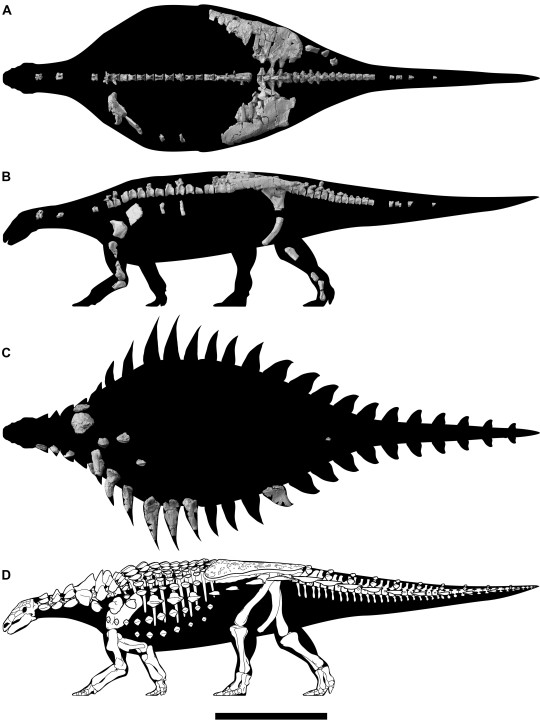
(Preserved bones and schematic skeletal of Vectipelta barretti [scale bar = 1 m], from Pond et al., 2023)
Meaning of name: Vectipelta = Isle of Wight shield [in Latin]; barretti = for Paul M. Barrett [British paleontologist]
Age: Early Cretaceous (Barremian)
Where found: Wessex Formation, Isle of Wight, U.K.
How much is known: Partial skeleton of one individual including much of the vertebral column, some limb bone fragments, and many armor plates. Some additional ankylosaur material from the same locality may belong to the same species (or even the same individual), but this cannot be confirmed at present.
Notes: Vectipelta was an ankylosaur, a group of armored herbivorous dinosaurs. Two other ankylosaurs have known from the Early Cretaceous of England since the 19th Century, the older Hylaeosaurus and the younger Polacanthus. However, Vectipelta appears to have been only distantly related to either of them, and may have instead been more closely related to the club-tailed ankylosaurine ankylosaurs. Traditionally, ankylosaur fossils from the Wessex Formation have often been classified as Polacanthus by default, but the discovery of Vectipelta indicates that this is not always a safe assumption to make.
Reference: Pond, S., S.-J. Strachan, T.J. Raven, M.I. Simpson, K. Morgan, and S.C R. Maidment. 2023. Vectipelta barretti, a new ankylosaurian dinosaur from the Lower Cretaceous Wessex Formation of the Isle of Wight, UK. Journal of Systematic Palaeontology 21: 2210577. doi: 10.1080/14772019.2023.2210577
108 notes
·
View notes
Text





Polacanthus foxii
(temporal range: 130-125 mio. years ago)
[text from the Wikipedia article, see also link above]
Polacanthus, deriving its name from the Ancient Greek polys-/πολύς- "many" and akantha/ἄκανθα "thorn" or "prickle",[5] is an early armoured, spiked, plant-eating ankylosaurian dinosaur from the early Cretaceous period of England.
In the genus Polacanthus several species have been named but only the type species Polacanthus foxii is today seen as valid.
Polacanthus was a quadrupedal ornithischian or "bird-hipped" dinosaur. It lived 130 to 125 million years ago in what is now western Europe.[6] Polacanthus foxii was named after a find on the Isle of Wight in 1865. There are not many fossil remains of this creature, and some important anatomical features, such as its skull, are poorly known. Early depictions often gave it a very generic head as it was only known from the rear half of the creature. It grew to about 5 metres (16 ft) long. Its body was covered with armour plates and spikes. It possibly was a basal member of the Nodosauridae.
42 notes
·
View notes